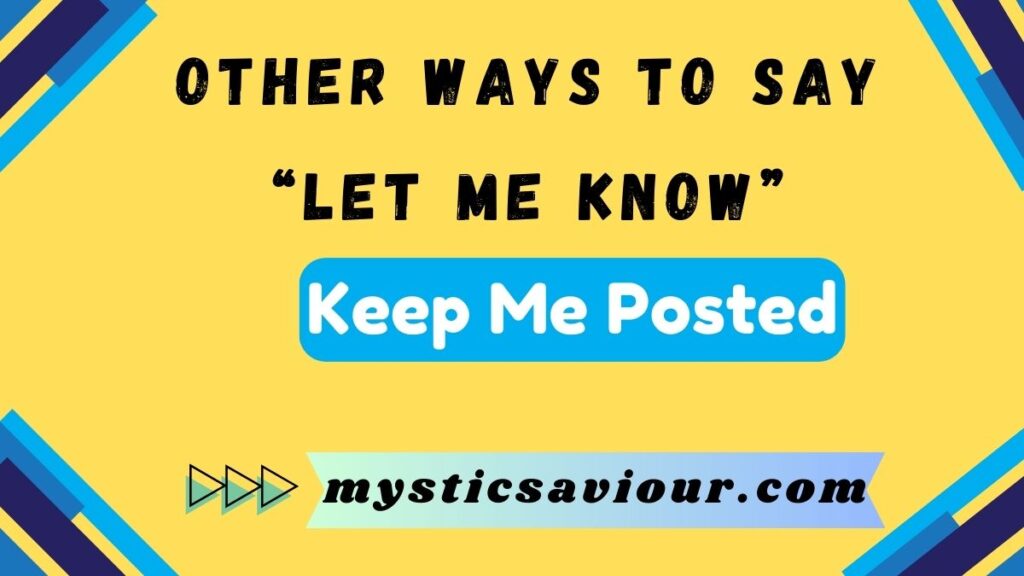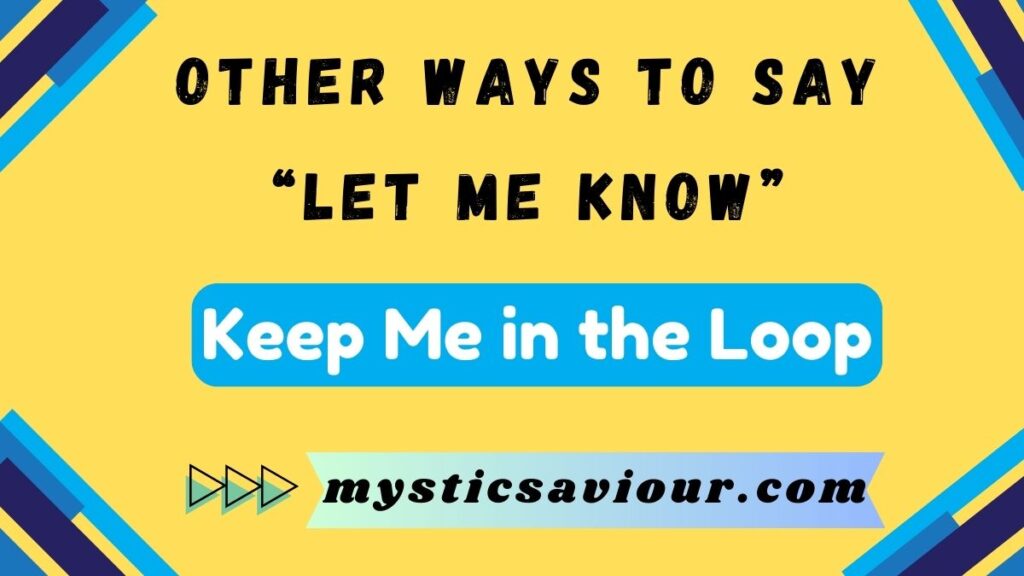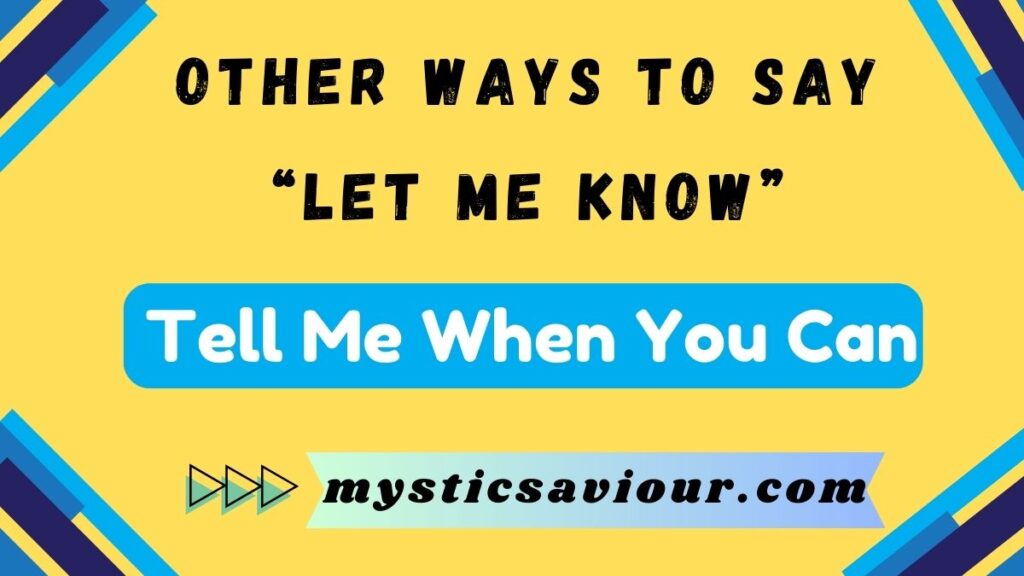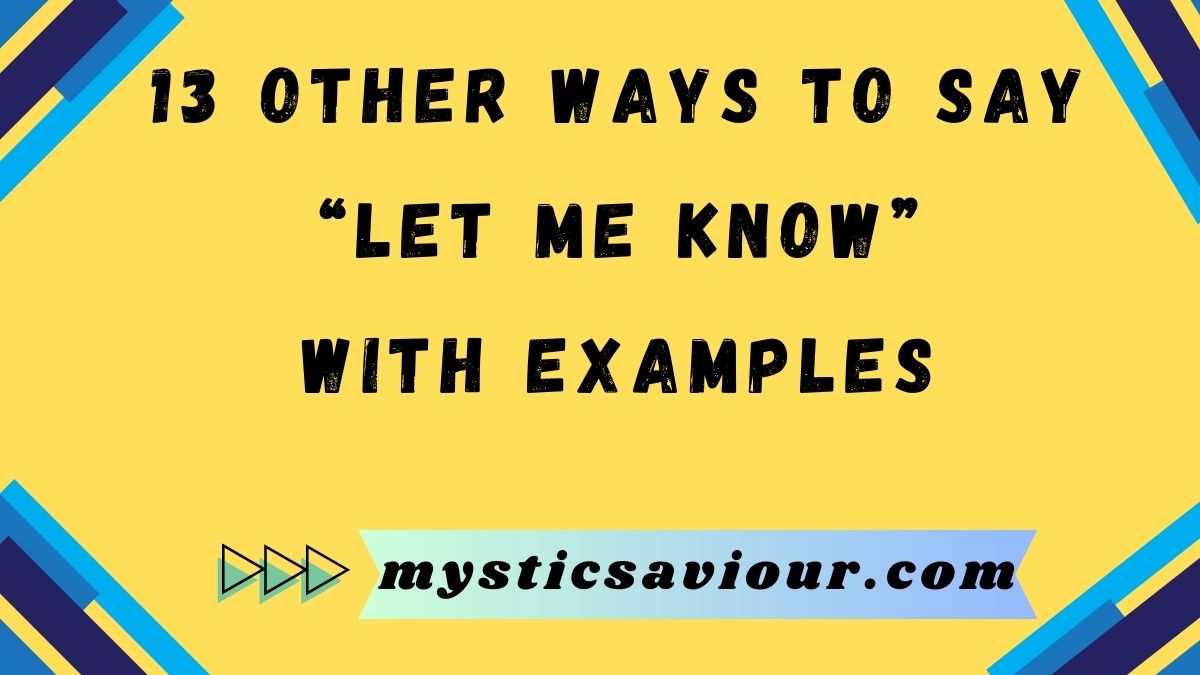When it comes to effective communication, variety is key. One phrase that often gets overused is “let me know.” While it’s a simple and convenient way to ask for information, relying too heavily on it can make your conversations sound repetitive and dull. Fortunately, there are numerous alternatives to “let me know” that can make your messages more engaging, dynamic, and tailored to different situations. In this article, we’ll explore 13 other ways to say “let me know,” along with examples to help you expand your vocabulary and communicate with more flair.
Imagine adding a touch of creativity to your everyday conversations, making them sound more natural and impactful. By replacing the generic “let me know” with these fresh alternatives, you’ll not only keep your communication interesting but also connect with others more effectively. Whether you’re at work, texting a friend, or emailing a colleague, these alternative phrases will elevate the way you interact with those around you.
The right phrase can completely change the tone of a conversation, helping you express yourself with precision and personality. This list of 13 alternatives includes options that range from casual to formal, giving you the flexibility to adapt to any situation. Ready to refresh your communication style? Let’s dive into these creative and practical alternatives that will help you stand out!
1. Keep Me Posted

Meaning:
“Keep me posted” is a casual yet effective way to ask for regular updates or information. It’s commonly used in professional and social settings when you want to stay informed about a situation.
Example:
- “Keep me posted on how the negotiations go. I’m interested to hear how it turns out.”
When to Use:
- Professional Setting: Perfect for workplace conversations when you need to stay updated on a project or event.
- Casual Setting: Works when you’re checking in with friends or acquaintances about something they’re involved in.
By using this phrase, you’re telling someone to keep you in the loop, so you’re not left out of any important details.
2. Update Me
Meaning:
Asking someone to update you is a direct and slightly formal way of requesting information, especially if it’s related to a task or an event you’re involved in.
Example:
- “Update me once the reports are ready so I can review them.”
When to Use:
- Workplace Communication: It’s appropriate when you need specific information, particularly in a business environment.
- Casual Conversations: Can also be used when you’re asking for progress on something important to you, like a friend’s travel plans.
“Update me” signals that you want new, actionable information—perfect for professional settings or times when you need precise facts.
3. Inform Me
Meaning:
The phrase “inform me” carries a more formal tone than “let me know,” making it suitable for situations that demand clarity and precision. It’s perfect when you’re requesting someone to share something important.
Example:
- “Please inform me of any changes to the meeting schedule.”
When to Use:
- Formal/Professional Setting: This is ideal for professional emails, reports, or formal conversations.
- Situations Requiring Detailed Information: Use when you need a clear explanation or when a more authoritative tone is needed.
“Inform me” is often used in corporate communication or when addressing someone in a higher position.
4. Fill Me In
Meaning:
“Fill me in” is an informal and friendly way of asking someone to provide you with details you might have missed or don’t know about yet. It’s great when you want to catch up on the latest developments.
Example:
- “I was out yesterday. Can you fill me in on what happened during the meeting?”
When to Use:
- Informal/Collegial Conversations: Best suited for chatting with colleagues or friends when you’re looking to catch up.
- Casual Check-Ins: It’s perfect for asking someone to bring you up to speed on a situation.
This phrase implies a more conversational and approachable tone, encouraging open communication.
5. Give Me a Heads-Up

Meaning:
A “heads-up” is a casual warning or piece of advance notice. If you need someone to inform you of something before it happens, this is a great choice. It gives the sense that you’re expecting information ahead of time.
Example:
- “Give me a heads-up if the meeting is rescheduled, so I can adjust my schedule.”
When to Use:
- Informal Communication: It’s excellent when you’re talking to friends, colleagues, or teammates.
- When You Need Advance Notice: Use it when you want to be prepared for a change or update in the near future.
It’s a relaxed and friendly way to ask for prior notice, making your communication sound less rigid.
6. Drop Me a Line
Meaning:
“Drop me a line” is a friendly, informal way to ask someone to get in touch with you. It can be used when requesting someone to send you a message, usually in writing.
Example:
- “Drop me a line when you’re available to discuss the project.”
When to Use:
- Informal Communication: Perfect for personal texts or casual business exchanges.
- Texting or Messaging: Use when you want someone to contact you through a simple text or email.
This phrase carries a warm, friendly tone, suggesting that you’re open to communication without sounding demanding.
7. Keep Me in the Loop

Meaning:
When you ask someone to “keep you in the loop,” you’re requesting to be included in the flow of information. You want to stay updated and be part of ongoing communication.
Example:
- “Keep me in the loop about the client’s feedback so I can prepare the presentation accordingly.”
When to Use:
- Team or Collaborative Work: Great for situations where staying informed is crucial.
- Professional Settings: Common in corporate environments where transparency and communication are essential.
It’s a subtle way of asking to be informed regularly about a project or situation, helping you feel more involved and engaged.
8. Shoot Me an Email/Message
Meaning:
“Shoot me an email” or “Shoot me a message” is an informal yet common way of asking someone to send you a communication via email or text. It’s straightforward and to the point.
Example:
- “Shoot me an email once you have the details on the report.”
When to Use:
- Casual and Professional Settings: Ideal for quick exchanges that don’t require formality.
- When You Want Written Communication: This phrase implies that you want a text-based message.
This phrase is great when you’re looking for someone to communicate with you in writing, making it especially useful for professional settings.
9. Notify Me
Meaning:
“Notify me” is another formal way of requesting that someone provide you with an update or inform you of something important. It’s used when you expect timely notifications.
Example:
- “Notify me immediately if the shipment arrives.”
When to Use:
- Formal Business Communication: This is ideal when you need to request information in a professional or urgent context.
- Timely Updates: Use it when you require prompt notifications.
“Notify me” is often used in customer service settings or when you need to be informed of urgent matters.
10. Send Me Details
Meaning:
Asking someone to “send me details” is a direct way to request comprehensive information about something, whether it’s a project, event, or personal matter.
Example:
- “Send me details about the upcoming conference so I can plan accordingly.”
When to Use:
- Professional and Informal Contexts: Works well when you need specific, detailed information in either a work-related or casual context.
- Request for Specifics: Use it when you need thorough information rather than just a brief overview.
This phrase emphasizes that you’re looking for detailed insights and not just general updates.
11. Tell Me When You Can

Meaning:
“Tell me when you can” is a polite, non-urgent way to ask someone to provide you with information or updates at their convenience. It’s a softer approach, letting the other person know there’s no rush.
Example:
- “Tell me when you can confirm your attendance at the meeting.”
When to Use:
- Casual and Friendly Settings: It’s perfect for informal conversations with friends or colleagues.
- Non-Urgent Situations: When the timing isn’t critical, and you’re just looking for a response when the person is ready.
This phrase conveys patience and allows the recipient flexibility, making it feel more relaxed and considerate.
12. Let Me Know What You Think
Meaning:
Sometimes you want feedback, and a simple “let me know what you think” is a great way to ask for someone’s opinion or thoughts on something. It can be used in both formal and informal settings when you’re open to hearing others’ views.
Example:
- “Let me know what you think about the new design proposal.”
When to Use:
- Collaborative or Creative Settings: It’s perfect for getting feedback on a new idea, product, or plan.
- Casual Discussions: It works well when you’re casually asking for a friend’s opinion.
This phrase invites dialogue and shows that you value the other person’s perspective.
13. Hit Me Up
Meaning:
“Hit me up” is a very casual way of telling someone to get in touch with you. It’s typically used in text messages or social media conversations.
Example:
- “Hit me up if you need any help with the project.”
When to Use:
- Casual Conversations: Ideal for informal, friendly chats with friends or colleagues.
- Non-Professional Situations: Works best when the communication is low-pressure and informal.
It’s a laid-back phrase that encourages informal contact and suggests you’re easy to reach.
Conclusion
In conclusion, exploring 13 Other Ways to Say “Let Me Know” (With Examples) gives you a variety of phrases to use in different situations. By mixing up your language, you can keep your conversations fresh and engaging. Whether in professional or casual settings, these alternatives help you sound more natural and connected.
Next time you need to ask someone for an update or information, try using one of these phrases. It’s a simple way to enhance your communication and make it more interesting. With these 13 Other Ways to Say “Let Me Know” (With Examples), you’ll find the perfect phrase for every situation. So, go ahead, start mixing it up, and enjoy more dynamic conversations!

Sophie Bell is a creative writer at Mystic Saviour, specializing in Word Mechanics, Name Narratives, and Linguistic Twists. She brings a passion for language and storytelling, helping readers explore unique and engaging ways to enhance their writing.










